
Secara harfiah, deforestasi bisa diartikan sebagai kehilangan hutan. Sehingga sangat penting untuk mendudukkan kembali definisi hutan sebagai dasar dalam memahami deforestasi. Di dalam Undang-undang kehutanan, disampaikan bahwa hutan merupakan karunia dan amanat Tuhan Yang Maha Esa yang dianugerahkan kepada bangsa Indonesia. Sebuah anugerah yang tidak ternilai, karena hutan telah tumbuh dan berkembang secara alami di daratan Indonesia tanpa bangsa ini harus berupaya untuk menanam ataupun memeliharanya. Lebih lanjut disebutkan dalam Undang-undang No 41 tahun 1999 pada pasal satu angka dua, “hutan adalah suatu kesatuan ekosistem berupa hamparan lahan berisi sumber daya alam hayati yang didominasi pepohonan dalam persekutuan alam lingkungannya, yang satu dengan lainnya tidak dapat dipisahkan.” Dengan demikian, mendefinisikan hutan seyogyanya tidak hanya mengartikannya hanya sebagai sekumpulan pepohonan, tetapi juga peran dan fungsinya sebagai salah satu penentu sistem penyangga kehidupan dan bahkan juga menjadi ruang hidup bagi seluruh makhluk hidup tidak terkecuali manusia.
Sehubungan dengan isu perubahan iklim global, bahwa Indonesia telah mengesahkan Konvensi Kerangka Kerja Perserikatan Bangsa-Bangsa Mengenai Perubahan Iklim melalui Undang Undang No 6 tahun 1994. Dan bahwa kegiatan aforestasi dan reforestasi mempunyai kontribusi terhadap penyerapan karbon dioksida untuk menurunkan efek rumah kaca melalui Mekanisme Pembangunan Bersih (MPB). Melalui Permenhut no 14 tahun 2004 tentang Aforestasi dan Reforestasi dalam kerangka Mekanisme Pembangunan Bersih (MPB), hutan didefinisikan sebagai lahan yang luasnya minimal 0,25 ha dan ditumbuhi oleh pohon dengan persentasi penutupan tajuk minimal 30% yang pada akhir pertumbuhan mencapai ketinggian minimal 5 meter. Definisi ini secara teknis lebih operasional dalam rangka mengidentifikasi tutupan hutan dan menghitung besaran stok karbon, serapan karbon dan juga emisi karbon, bahkan untuk skala luas sekalipun dengan menggunakan teknik penginderaan jauh.
Terkait dengan deforestasi, definisi yang digunakan oleh pemerintah Indonesia saat ini merujuk pada Peraturan Menteri Lingkungan Hidup dan Kehutanan nomor 70 tahun 2017 tentang tata cara pelaksanaan reducing emissions from deforestation and forest degradation, role of conservation, sustainable management of forest and enhancement of forest carbon stocks. Dalam aturan tersebut, deforestasi didefinisikan sebagai perubahan secara permanen dari areal berhutan menjadi tidak berhutan yang kemudian dibagi menjadi Deforestasi Gross dan Deforestasi Nett. Deforestasi Gross adalah perubahan secara permanen tutupan hutan alam tanpa memperhitungkan pertumbuhan kembali (regrowth) dan atau pembuatan hutan tanaman. Deforestasi Nett adalah perubahan secara permanen tutupan hutan, dengan memperhitungkan pertumbuhan kembali (regrowth) dan/atau pembuatan hutan tanaman. Dan didefinisikan juga mengenai degradasi hutan sebagai penurunan kuantitas tutupan hutan dan stok karbon selama periode tertentu.
Pendefinisian hutan dan deforestasi dalam dua (2) Peraturan Menteri bidang kehutanan tersebut, sangat tepat relevansinya untuk melihat hutan dan perubahannya sebagai bagian dari pengurangan emisi. Dan hal ini secara eksplisit dinyatakan dalam diktum menimbang pada Peraturan Menteri Lingkungan Hidup dan Kehutanan nomor 70 tahun 2017. Disebutkan bahwa target penurunan emisi gas rumah kaca nasional sebesar 29% (dua puluh sembilan persen) (unconditional) sampai dengan 41% (empat puluh satu persen) (conditional) dibandingkan dengan Bussines as Usual – BAU pada Tahun 2030 dilaksanakan melalui kegiatan mitigasi diantaranya bidang Penggunaan Lahan, Perubahan Penggunaan Lahan dan Kehutanan (Land Use, Land Use Change and Forestry). Dan bahwa aksi mitigasi di sektor kehutanan dilaksanakan melalui pengurangan emisi dari deforestasi dan degradasi hutan, konservasi stok karbon hutan, pengelolaan hutan lestari dan peningkatan stok karbon hutan.
Bagaimana Angka Resmi Deforestasi Pemerintah?
Laju deforestasi hutan Indonesia pada periode tahun 1985-1998 tidak kurang dari 1,6 – 1,8 juta hektar per tahun (Dephutbun, 2000). Pada tahun 2000, laju deforestasi meningkat menjadi paling tidak 2 juta hektare per tahun (FWI/GFW, 2001). Menurut KLHK, Selama Orde Reformasi sampai saat ini deforestasi semakin menurun, pada tahun 2016-2017 berada di angka 0,48 juta hektare.
Dalam beberapa tahun terakhir, KLHK melakukan pembaharuan data dan mempublikasikan angka deforestasi per tahun, tentunya dengan definisi deforestasi sebagaimana disebutkan dalam Peraturan Menteri Lingkungan Hidup dan Kehutanan nomor 70 tahun 2017. Data resmi menunjukkan bahwa pada periode 2013-2014 deforestasi turun ke angka 0,4 juta hektar per tahun setelah pada periode sebelumnya berada pada angka 0,73 juta hektar per tahun. Angka deforestasi kemudian naik pada periode 2014-2015 menjadi 1,09 juta hektare per tahun lalu turun menjadi 0,63 juta hektare per tahun pada periode 2015-2016 dan turun kembali ke angka 0,48 juta hektare per tahun pada periode 2016-2017 (Gambar 1).
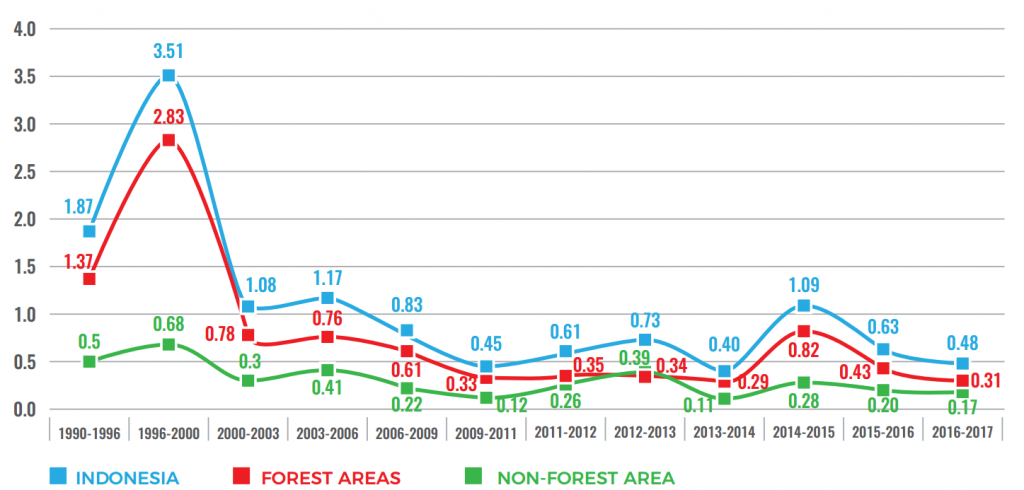
FWI kemudian menggali lebih dalam dengan menggunakan data yang sama untuk mengetahui bagaimana definisi deforestasi hutan alam, deforestasi bruto dan deforestasi netto bekerja secara operasional.
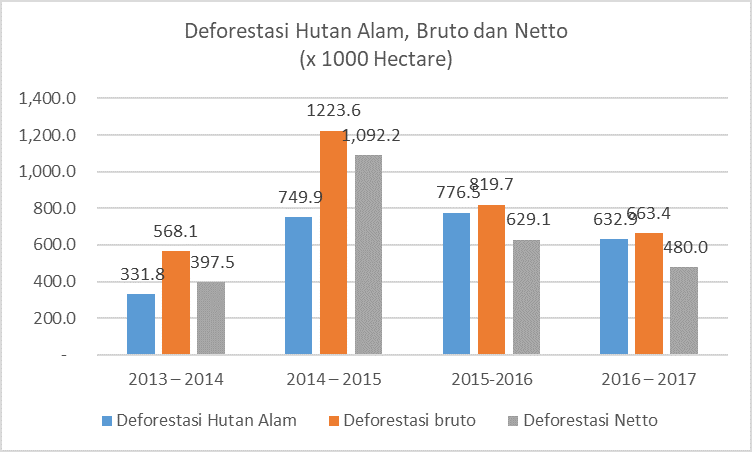
Tabel 1. Persentase Perubahan Deforestasi Periode 2013-2017
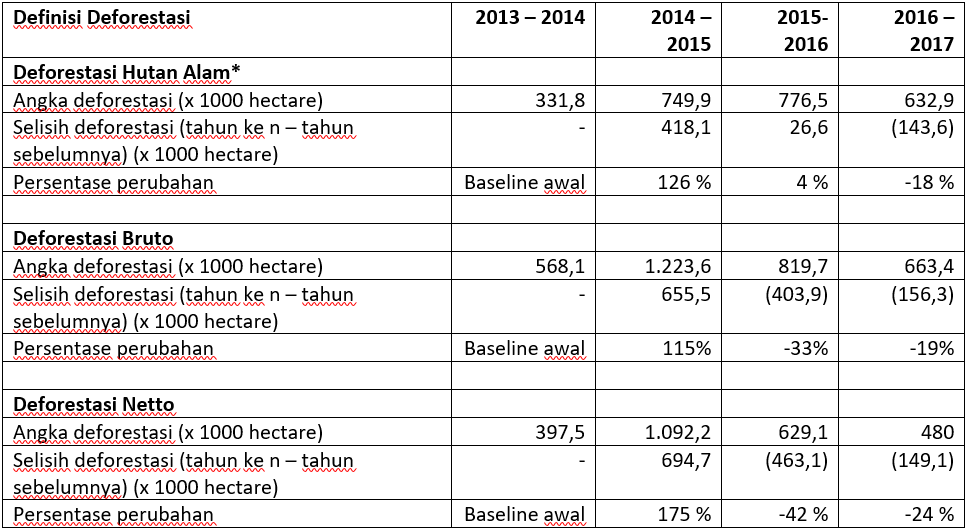
Berdasarkan Gambar 2 dan Tabel 1, dengan pendekatan definisi deforestasi hutan alam, angka deforestasi pada hutan alam mengalami peningkatan sekitar 126 persen pada periode 2014-2015. Lalu, angka deforestasi pada hutan alam kembali mengalami peningkatan sekitar 4 persen pada periode 2015-2016. Dan baru pada periode 2016-2017, angka deforestasi turun sekitar 18 persen dibanding dengan periode tahun sebelumnya. Untuk menggunakan pendekatan definisi deforestasi bruto. Angka deforestasi bruto mengalami peningkatan sebesar 115 persen pada periode 2014-2015. Lalu angka tersebut turun sebesar 33 persen pada periode 2015-2016. Pada periode 2016-2017 deforestasi kembali turun dengan persentase sebesar 19 persen. Sedangkan bila menggunakan pendekatan definisi deforestasi netto, angka deforestasi netto mengalami peningkatan sekitar 175 persen pada periode 2014-2015. Lalu angka tersebut turun sebesar 42 persen pada periode 2015-2016. Pada periode 2016-2017 deforestasi kembali turun dengan persentase sebesar 24 persen.
Pendekatan definisi deforestasi hutan alam, bruto dan netto menunjukkan perbedaan angka deforestasi yang terjadi. Perbedaan juga terjadi pada pola perubahan deforestasi dimana angka deforestasi pada hutan alam baru menunjukkan penurunan setelah tahun terakhir dalam 4 tahun periode analisis. Sedangkan untuk angka deforestasi bruto dan netto sudah menunjukkan penurunan setelah periode tahun ke 3.
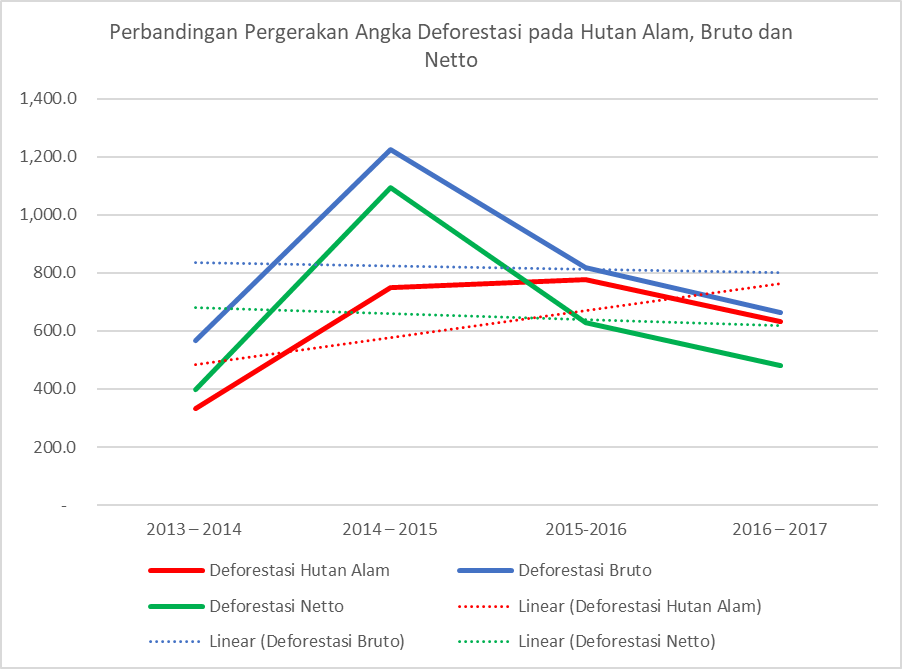
Gambar 3 menunjukkan perbandingan pergerakan angka deforestasi antara deforestasi hutan alam, deforestasi bruto dan deforestasi netto. Secara linier terlihat bahwa grafik deforestasi bruto dan netto terus mengalami penurunan, sedangkan grafik untuk deforestasi hutan alam menunjukkan hal berkebalikan yaitu kenaikan.
Sebagaimana diketahui dalam pendefinisian hutan, pro dan kontra juga terjadi untuk kelas hutan tanaman. Berdasarkan definisi hutan dalam UU 41/1999, hutan dipandang sebagai sebuah ekosistem dan tidak dibedakan sebagai hutan alam maupun hutan tanaman. Hal tersebut bisa jadi merupakan basis argumentasi untuk memasukkan hutan tanaman sebagai bagian dari hutan. Sedangkan pandangan lain menyebutkan bahwa hutan tanaman tidak ubahnya seperti perkebunan kayu, karena hutan tanaman merupakan hasil budidaya manusia dengan menanam jenis pohon yang homogen dalam skala luas. Terlepas dari pro dan kontra tersebut, penting kemudian untuk mendudukkan ulang hutan alam dan hutan tanaman sebagai entitas yang berbeda dari hutan dan karena ini juga penting sebagai bagian dari analisis untuk menelisik deforestasi di Indonesia lebih dalam.

Dari gambar 4, terlihat bahwa deforestasi di Indonesia dalam periode 2013-2017 sebagian besar dialami oleh hutan alam. Sedangkan untuk reforestasi, pada 2 tahun awal periode tersebut didominasi oleh reforestasi yang terjadi pada hutan tanaman dan baru pada 2 tahun berikutnya reforestasi hutan alam yang lebih dominan. Sedangkan pada gambar 5, lebih jelas menunjukkan proporsi hutan alam yang ter-deforestasi dan ter-reforestasi. Yang menarik bila dilihat dari proporsinya deforestasinya, persentase deforestasi hutan alam terus mengalami kenaikan dari tahun ketahun, meski dari segi luasan deforestasinya terlihat pola kenaikan pada tahun ke 2 dan menurun setelahnya.
Berdasarkan hasil pembahasan diatas, pada periode 2013-2017, rata-rata deforestasi hutan alam di Indonesia berada di angka 650 ribu hektare pertahun. Lalu dengan menggunakan pendekatan definisi deforestasi bruto dan netto menunjukkan adanya pola perubahan deforestasi yang sama meski besaran persentase kenaikan maupun penurunan deforestasinya berbeda. Angka deforestasi pada keduanya sama sama mengalami kenaikan pada tahun ke 2 dan terus turun setelahnya. Sedangkan bila menggunakan pendekatan deforestasi hutan alam, pola perubahan deforestasi terus mengalami kenaikan hingga tahun ke 3 dan baru mengalami penurunan pada tahun ke 4.
Selain itu dengan membandingkan persentase deforestasi pada hutan alam dan hutan tanaman, meski dari segi jumlah luasannya menurun, terlihat bahwa deforestasi dominan terjadi pada hutan alam dan cenderung terus mengalami kenaikan dari awal periode tahun analisisnya. Temuan lain dari analisis deforestasi tersebut adalah adanya kejanggalan atas perubahan angka deforestasi dan reforestasi pada hutan tanaman. Sebagaimana ditunjukkan dalam gambar 6, terlihat bahwa deforestasi dan reforestasi pada hutan tanaman dalam periode 2013 – 2017 memiliki gap yang cukup besar setiap tahunnya. Bahkan antara periode 2014-2015 dengan 2015-2016, deforestasinya turun dari angka 473,6 ribu hektare menjadi 43,2 ribu hektare. Begitupun juga dengan reforestasi yang terjadi yaitu dari angka 122,6 ribu hektare menjadi 63,2 ribu hektare. Melihat angka deforestasi dan reforestasi pada hutan tanaman secara khusus sangat berkaitan dengan bisnis proses dalam hutan tanaman sendiri. Proses deforestasi pada hutan tanaman dapat diasumsikan adalah proses panen, sedangkan reforestasi pada hutan tanaman dapat diasumsikan sebagai proses tanam. Dimana keduanya adalah bagian dari sistem silvikultur yang dapat menjadi indikasi kinerja pembangunan hutan tanaman.
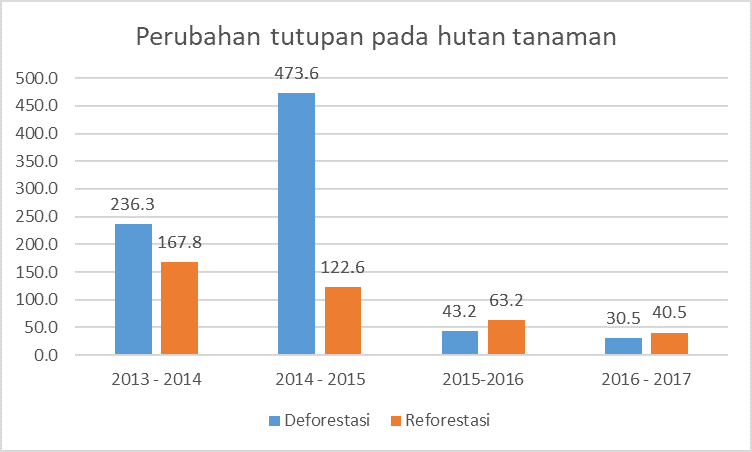
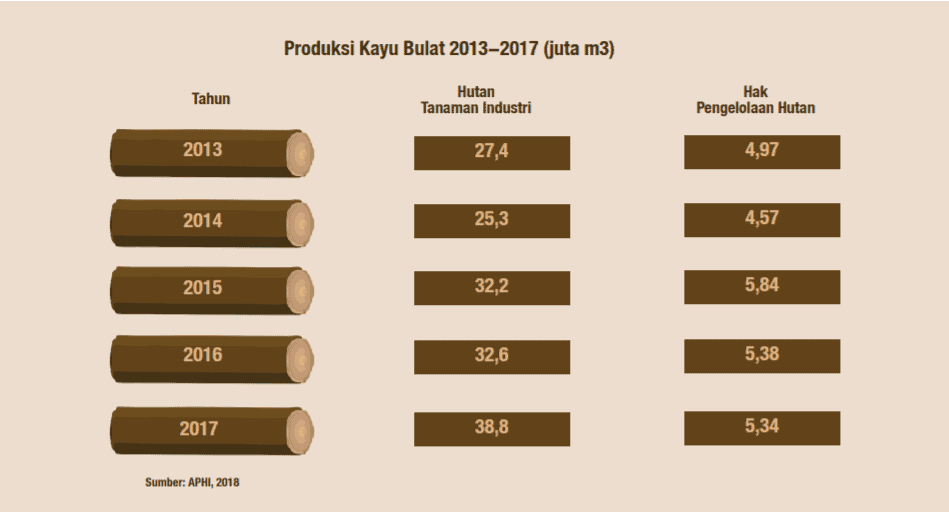
Apabila dibandingkan dengan data produksi kayu bulat dari Hutan Tanaman Industri, dalam kurun waktu 2013-2017 (Gambar 8), volumenya dalam 2 tahun terakhir malah naik. Karena hutan tanaman merupakan kayu seumur dan sejenis dengan riap pertumbuhan relatif tidak jauh berbeda, tentu luasan yang dibutuhkan dalam memproduksi angka tersebut tidak akan jauh berbeda. Berdasarkan data perubahan tutupan hutan tanaman yang sangat jauh gapnya tersebut tentunya menjadi pertanyaan tersendiri terhadap akurasi data tutupan lahan yang dirilis oleh KLHK.
Catatan Kritis Data Deforestasi Versi Pemerintah
Definisi deforestasi yang digunakan oleh pemerintah lebih ditujukan sebagai landasan informasi dalam kebijakan terkait dengan isu perubahan iklim. Mekanisme penghitungan karbon yang diimplementasikan dalam pendefinisian hutan dan perubahannya secara langsung telah mereduksi definisi yang ada di Undang-Undang Kehutanan. Indikasinya, bahwa data deforestasi yang secara agregat menunjukkan penurunan, tetapi perspektif lain atas data yang sama menunjukkan bahwa deforestasi hutan alam di Indonesia malah menunjukkan peningkatan.
Perbedaan data tutupan hutan dan lahan dengan asumsi data produksi kayu dari hutan tanaman industri, menunjukkan ada indikasi ketidaksesuaian. Di sisi lain, data tutupan lahan yang dikeluarkan oleh KLHK tidak bisa diuji akuntabilitasnya oleh publik, karena data spasial tutupan lahan ini bukan merupakan bagian dari informasi publik. Hal ini berdasarkan surat edaran Menteri Lingkungan Hidup dan Kehutanan SE.4/Menlhk/PKTL/KUM.1/11/2016 tentang Pemberian Data dan Informasi Spasial Lingkungan Hidup dan Kehutanan.
Keterbukaan atas informasi merupakan hal mutlak yang harus dilakukan, agar kebenaran informasi tentang hutan dan perubahan tutupannya tidak didominasi oleh klaim pemerintah.
Sumber box : FWI.Potret Keadaan Hutan Indonesia periode tahun 2013-2017.2019
Catatan: Tulisan ini telah direvisi dari versi sebelumnya untuk memudahkan pembaca memahami konteks permasalahan




